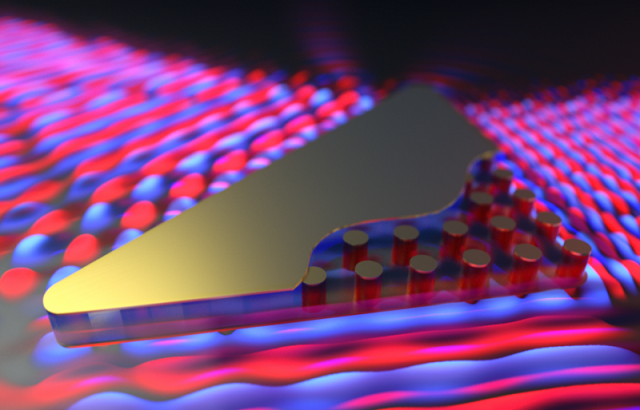Signal transmission using electrons is expected to quickly become a thing of the past. Photonic devices, which use light to rapidly transmit large volumes of information are expected to enhance, and replace, the electronic devices that we use on a daily basis. However, researchers still need to determine how to effectively manipulate light at the nanoscale before photonic devices can be integrated into computers and tellecommunications systems.
 The structure of the silicon-based metamaterial
The structure of the silicon-based metamaterial
New research has brought this achievement one step closer by designing the first ever on-chip metamaterial with a refractive index of zero, allowing light to travel infinitely fast.
This huge breakthrough was the result of the work of Professor Eric Mazur and his team from Harvard University's School of Engineering and Applied Sciences (SEAS)
Light doesn’t typically like to be squeezed or manipulated but this metamaterial permits you to manipulate light from one chip to another, to squeeze, bend, twist and reduce diameter of a beam from the macroscale to the nanoscale. It’s a remarkable new way to manipulate light.
Professor Eric Mazur - SEAS
The transport of light at an infinitely high velocity initially appears to break the rules of relativity, which states light moves at velocity of approximately 300,000,000 meters per second. This is still true, nothing can travel faster than light in a vacuum.
However light has another velocity, measured by the rate at which it's wavelength crests are moved, called the phase velocity. The phase velocity of light is material dependent, i.e. light moves at different velocities depending on the medium it travels through.
For example, when light is transmitted through water it's phase velocity is reduced and it's wavelengths are compressed together. Once the light then exits the water, into a less dense medium, it experiences an increase in phase velocity resulting in an elongation of its wavelength.
The magnitude by which the phase velocity changes when light is transmitted between different mediums is expressed as a ratio - termed the refractive index. The greater the value of the refractive index the greater the change of the phase velocity.
Water has a refractive index of 1.3, whereas air has a refractive index of 1. It is this difference that results in the strange visual effects that occur when objects are submerged in water. When the refractive index is reduced to zero some very unusual and interesting behavior is observed.
In zero-index materials the light does not behave as a propagating wave, i.e. it is no longer characterized with crests and troughs, and instead has a constant phase.
This constant phase light is observed as all crests (or all troughs) which stretch over an infinitely long wavelength. The crests and troughs only oscillate with respect to time, and not to space.
The light's uniform phase allows it to be manipulated by twisting, turning, squashing and stretching; with no loss of the lights energy. A zero-index material that is based on a chip would be ideal for use in exciting applications such as quantum computing.
Integrated photonic circuits are hampered by weak and inefficient optical energy confinement in standard silicon waveguides.
This zero-index metamaterial offers a solution for the confinement of electromagnetic energy in different waveguide configurations because its high internal phase velocity produces full transmission, regardless of how the material is configured.
Yang Li - SEAS
The zero refractive-index metamaterial consits of a polymer matrix, with silicon pillar arrays embedded into is, which is surrounded by a gold film. The chip can also be coupled to silicon waveguides, allowing integration into established photonics chips.
In quantum optics, the lack of phase advance would allow quantum emitters in a zero-index cavity or waveguide to emit photons which are always in phase with one another.
It could also improve entanglement between quantum bits, as incoming waves of light are effectively spread out and infinitely long, enabling even distant particles to be entangled.
Philip Munoz- SEAS
The research is described in the journal Nature Photonics.